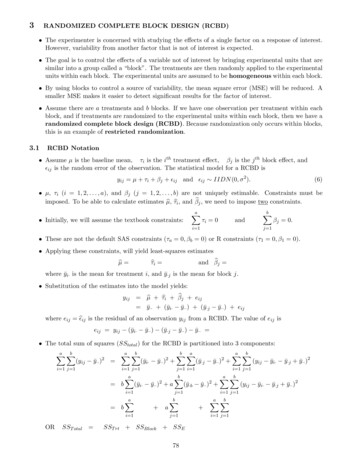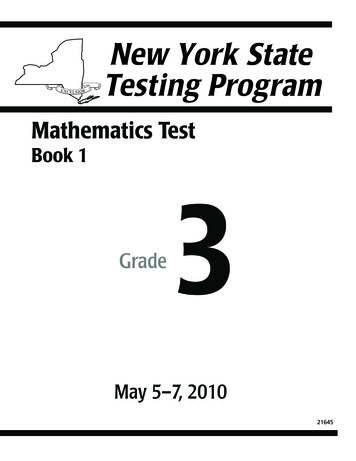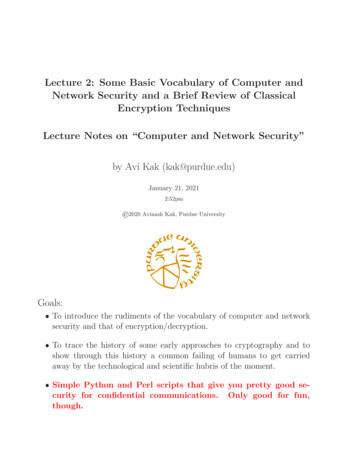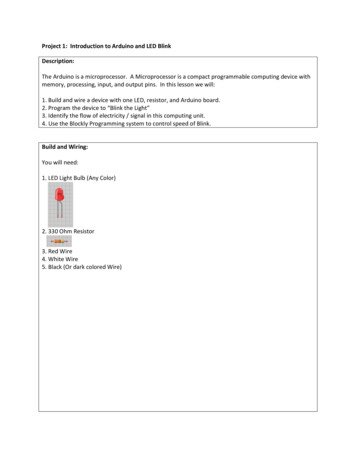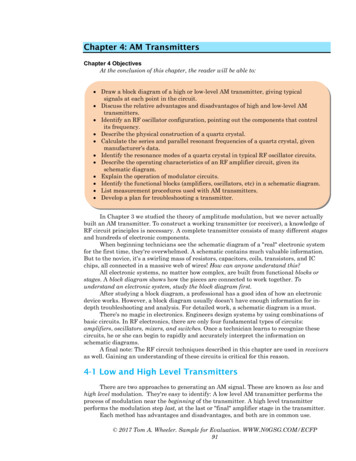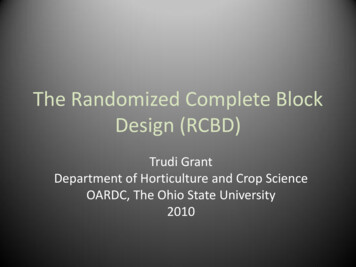
Transcription
The Randomized Complete BlockDesign (RCBD)Trudi GrantDepartment of Horticulture and Crop ScienceOARDC, The Ohio State University2010
The objective of this tutorial is to give a briefintroduction to the design of a randomizedcomplete block design (RCBD) and the basicsof how to analyze the RCBD using SAS.
The RCBD is the standard design for agriculturalexperiments where similar experimental unitsare grouped into blocks or replicates.It is used to control variation in an experimentby accounting for spatial effects in field orgreenhouse.e.g. variation in fertility or drainage differencesin a field
The field or space is divided into uniform unitsto account for any variation so that observeddifferences are largely due to true differencesbetween treatments.Treatments are then assigned at random tothe subjects in the blocks-once in each blockThe defining feature of the RandomizedComplete Block Design is that each block seeseach treatment exactly once
Advantages of the RCBDGenerally more precise than the completelyrandomized design (CRD).No restriction on the number of treatments orreplicates.Some treatments may be replicated moretimes than others.Missing plots are easily estimated.
Disadvantages of the RCBDError degrees of freedom is smaller than thatfor the CRD (problem with a small number oftreatments).Large variation between experimental unitswithin a block may result in a large error termIf there are missing data, a RCBD experimentmay be less efficient than a CRDNOTE: The most important item to considerwhen choosing a design is the uniformity ofthe experimental units.
The Layout of the Experiment Choose the number of blocks (minimum 2)– e.g. 4 Choose treatments (assign numbers or lettersfor each)– e.g. 6 trt – A,B, C, D, E, F
1234BlocksThe number of blocksis the number ofreplicationsABCTreatments are assigned atrandom within blocks ofadjacent subjects, eachtreatment once per block.DEFTreatmentsImage credit: Francis Lab, The Ohio State UniversityAny treatment can be adjacent to anyother treatment, but not to the sametreatment within the block
The first step is to randomizethe treatments and blocks.This can be done in excelusing the RAND functionExcel randomizationTo generate random numbersUse RAND () ctrl enterRandomize blocks[DATA, SORT by column w/ rand()] Randomize treatments in each blockindependently
1. Column A –list of blocks2. Column BEnter rand()to generate arandomnumber3. Copy and paste commandin remaining cells
5. Select data then select sort6. Then sort by columnwith random numbers4. Select cellsOutput in excel showing randomized blocksin first column. This is repeated for eachblock to randomize the treatments
proc factex;factors block / nlev 4;output out blocksblock nvals (1 2 3 4);run;factors trt / nlev 6;output out rcbddesignrep blocksrandomize (101)trt cvals ('A' 'B' 'C''D' 'E' 'F');run;proc print data rcbd;run;Randomizationfor both blocks andtreatments can bedone using a SAS code
The SAS System14:30 Monday, August 4, 2008 3Obs block 1111333333444444BCADEFBCEAFDDACFBEAFBCDESAS outputshowingrandomizedblocks andtreatments
21B3B4DACCAFAECBDAFCEFBDFDEEImage credit: Francis Lab, The Ohio State UniversityExperimentaldesign showingrandomizedblocks andtreatments
Analysis using SASHave data in a format that can bedirectly imported into SAS or you cancopy and paste your data into SASIf importing data:Have 1st line for variable names anddata must start on line 2Make sure you have variable namesconsistent with SAS, use only letters,numbers and , and avoid spaces.
Model for RCBD Yij - any observation for whichi is the treatment factorj is the blocking factor μ - the mean Ti - the effect for being in treatment i Bj is the effect for being in block j
ANOVA tableSourceDegrees ofSums ofMean squaresFreedom squares (SS)Blocksb-1Block SSBMS BSS/b-1Treatmentt-1TreatmentSSTMS TSS/t-1Residual(t-1)(b-1)Residual SSRMS RSS/(t-1)(b-1)Totaltb-1SS TotalFBMS/RMSTMS/RMSt number of treatments, b number of blocksGM grand mean, BM block mean and TM treatment meanBSS Sum (BM-GM)2TSS Sum (TM-GM)2RSS Sum (V-BM-TM GM)2
SAS EditorData step: Creates a SASsystem data fileProc steps: Performoperations using the filescreated.Always end with ‘;’Programs for RCBD analysisProc GLMProc Mixed
SAS EditorThe program steps aredetermined by theexperimental design,how you collected yoursamples and how youwant your datapresented.
SAS code for Analysis of RCBDSample SAS GLM statements:PROC GLM;CLASS BLOCKS TREATS;MODEL WC BLOCKS TREATS;RUN;
SAS LogCheck forerrors in yourprogram.These areusuallyhighlightedin red.
SAS OutputCheck your ClassLevel informatione.g. Check for correctnumber of blocksand treatments
SAS OutputProvides degreesof freedom, sums ofsquares, F valuesand probabilities
SAS OutputIf the probabilitiesindicate significantdifferences, acomparison betweenmeans can be doneusing the LeastSignificant Difference(LSD)Written in your SAScode as:means trt/lsd
SAS OutputTreatments withdifferent lettershave significantdifferencesbetween them
External LinkSAS [Online]. SAS Institute. Available at: www.sas.com/ (verified 5 Jan2011).
Additional ResourceClewer, A. G., and D. H. Scarisbrick. 2001. Practical statistics and experimentaldesign for plant and crop science. John Wiley & Sons Ltd., New York.001. Practical statistics and experimental design for plant and crop science. JohnWiley & Sons Ltd., New York.
The RCBD is the standard design for agricultural experiments where similar experimental units are grouped into blocks or replicates. It is used to control variation in an experiment
